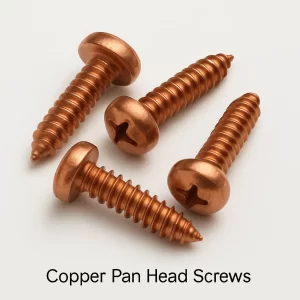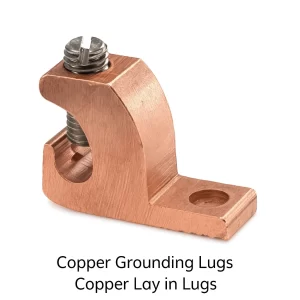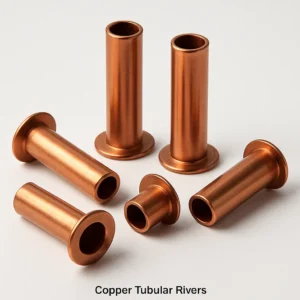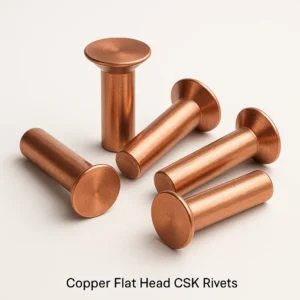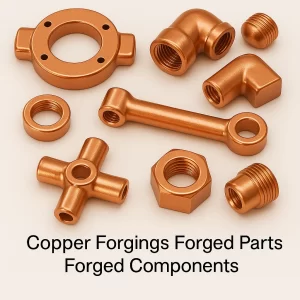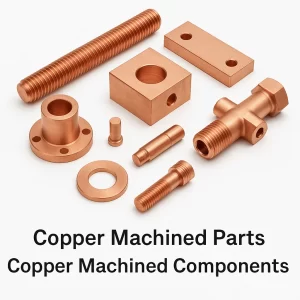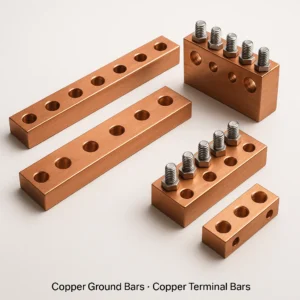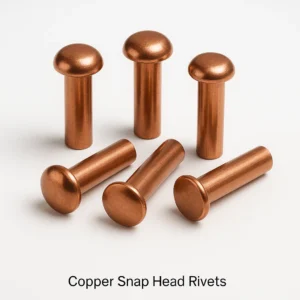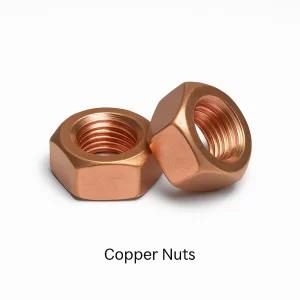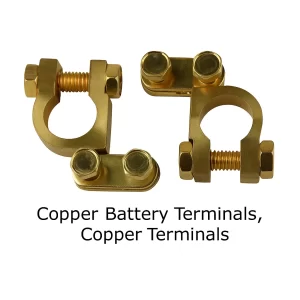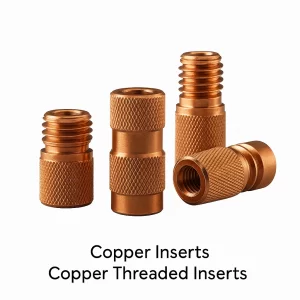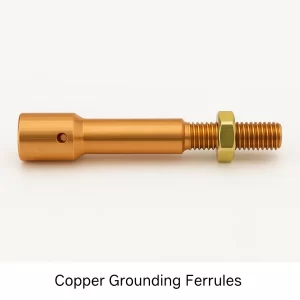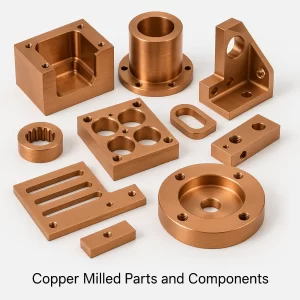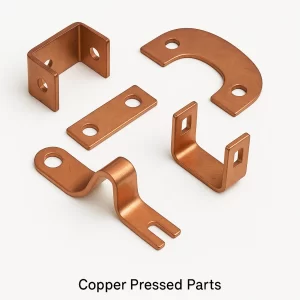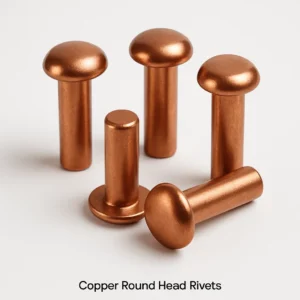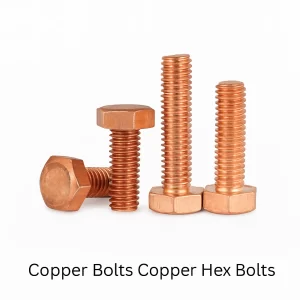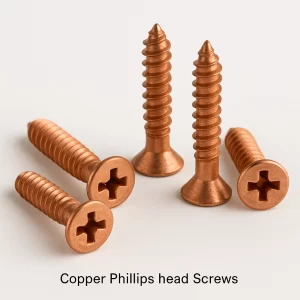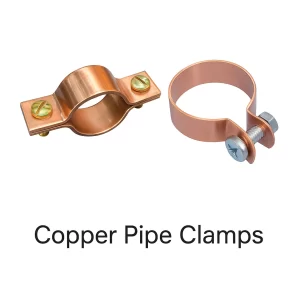Comprehensive Overview of Copper Studs and Transformer Studs
We are one of the leading manufacturers and exporters of Copper Studs and Transformer Studs from India. We have been supplying precision copper threaded studs, transformer terminal studs, copper electrical studs, copper double-end studs, and copper stud bolts to the world market for many decades. Our state-of-the-art manufacturing facility specializes in producing high-quality copper studs using advanced hot forging technology, precision CNC machining, cold heading processes, thread rolling and cutting operations, and comprehensive surface treatment capabilities. With over three decades of global experience in copper stud manufacturing, we serve diverse industries including electrical power transformers copper terminal studs, switchgear copper bus bar studs, electrical panel copper mounting studs, automotive copper electrical connection studs, railway copper electrical studs, marine copper hardware studs, industrial machinery copper mounting studs, and renewable energy copper connection studs. Our expertise encompasses working with various copper grades including pure Copper C11000 studs offering excellent electrical conductivity and thermal dissipation, Copper C10200 oxygen-free studs for high-performance electrical applications, Silicon Bronze C65500 studs for marine applications, Aluminum Bronze studs for high-strength requirements, Brass studs for decorative and functional applications, and tin-plated copper studs for enhanced solderability and corrosion protection. We manufacture copper studs ranging from small M6 threaded studs for electronics to large M30 studs for power distribution equipment and transformer terminals, all maintaining precise thread specifications, superior dimensional accuracy, excellent electrical conductivity, and reliable mechanical strength for critical electrical connection and mounting applications.
Our advanced manufacturing capabilities in producing precision copper transformer studs extend across multiple manufacturing processes including hot forging for large diameter copper studs with controlled grain flow and superior mechanical properties, cold heading machines for medium size studs with excellent dimensional consistency, CNC turning and threading operations for precision stud production with tight tolerances, thread rolling equipment creating high-strength threads with work-hardened surfaces and superior fatigue resistance, thread cutting on CNC lathes for specialty thread forms or custom specifications, centerless grinding for precise diameter control on stud shafts, surface grinding for flat bearing surfaces on flanged or shouldered studs, drilling operations for through-holes or blind holes in stud bodies, knurling operations for press-fit applications, and surface treatments including tin plating, nickel plating, or silver plating for enhanced electrical and corrosion properties. Our engineering team possesses deep technical knowledge of copper material properties, transformer terminal design standards per IEEE and IEC specifications, electrical connection requirements including current carrying capacity and contact resistance, mechanical loading analysis including tensile and shear strength, thermal management considerations for high-current applications, thread specifications per ISO metric and unified inch standards, torque requirements for proper installation preventing thread damage, and international electrical standards ensuring every copper stud meets or exceeds customer specifications and industry requirements. Our quality management system complies with ISO 9001:2015 standards, transformer manufacturing standards including IEEE C57 series, IEC 60076 power transformer standards, electrical equipment standards, customer-specific stud requirements, and industry standards for electrical, automotive, railway, and marine applications. We maintain complete traceability of copper raw material certificates, detailed manufacturing process documentation, dimensional inspection records using precision measuring equipment, thread verification reports using precision gauges, mechanical test results including tensile strength and proof load testing, electrical conductivity verification, and material test reports for every batch of copper studs produced. Our customers across North America, European Union countries, United Kingdom, Australia, Middle East regions, and Southeast Asian markets trust our copper stud expertise for their critical electrical connection, transformer terminal, and equipment mounting applications.
Copper Studs – Threaded Electrical Connection Components
Copper Studs represent specialized threaded fastening components manufactured from copper or copper alloys featuring external threads on one or both ends designed to provide secure mechanical connections combined with excellent electrical conductivity for current-carrying applications, thermal management through copper’s high thermal conductivity, corrosion resistance in various environments, and non-magnetic properties essential for electrical equipment. These copper studs are manufactured in various configurations including fully threaded studs with continuous threads along entire length enabling adjustable positioning and connection at any point, double-end studs with threaded sections on both ends separated by unthreaded shank providing fixed spacing between connected components, tap-end studs with one end designed for permanent installation into tapped hole and opposite end for nut attachment, shouldered studs with diameter change creating positive positioning and load distribution, flanged studs with integral flange providing bearing surface and eliminating washer requirements, and custom studs designed for specific application geometries and requirements. Copper studs find extensive applications in electrical power transformers including high-voltage transformer terminal studs connecting internal windings to external bushings, low-voltage transformer terminal studs for current output connections, transformer tank mounting studs, cooling system connection studs, and accessory mounting hardware, switchgear and distribution equipment including bus bar connection studs joining bus bar sections or connecting to equipment terminals, circuit breaker mounting studs, disconnect switch connection studs, metering panel studs, and electrical enclosure mounting hardware, electrical panels and control cabinets including ground bus bar mounting studs, neutral bar studs, equipment mounting studs for breakers and contactors, DIN rail mounting studs, and cable entry plate studs, automotive electrical systems including battery terminal studs connecting cable lugs to battery posts, alternator connection studs, starter motor studs, electrical distribution studs, and high-current connection hardware, railway electrical equipment including traction motor connection studs, pantograph electrical studs, power distribution studs for rolling stock, signaling system studs, and locomotive electrical hardware, marine electrical systems including ship power distribution studs, marine engine electrical connections, navigation equipment mounting studs, and corrosion-resistant saltwater environment hardware, renewable energy systems including solar inverter connection studs, wind turbine electrical studs, battery storage system connection hardware, and power conversion equipment studs, industrial machinery including motor connection studs, control panel mounting hardware, electrical junction box studs, and equipment grounding studs, and telecommunications equipment including power distribution studs, equipment rack mounting, grounding connection studs, and telecommunications shelter hardware.
Our copper stud manufacturing services include engineering consultation for stud design optimization based on electrical current requirements, mechanical loading conditions, thermal management needs, and installation environment, material selection guidance considering electrical conductivity requirements (pure copper for maximum conductivity), mechanical strength needs (copper alloys for higher strength), corrosion resistance (silicon bronze for marine), and magnetic properties (non-magnetic copper for electrical equipment), custom stud design for non-standard dimensions, thread specifications, or unique features including through-holes, cross-holes, or special profiles, prototype development with dimensional verification and electrical testing validation, production manufacturing with consistent quality across batches using appropriate forging, machining, or forming processes, various thread specifications including metric coarse pitch (M6 x 1.0 through M30 x 3.5), metric fine pitch for precision applications, unified inch threads (1/4″-20 through 1-1/4″-7), ACME threads for high load capacity, and custom thread forms, stud configurations including fully threaded, double-end with specified grip length, tap-end with length ratios, shouldered with diameter transitions, flanged with integral bearing surface, and custom geometries, dimensional capabilities from small M6 x 30mm studs to large M30 x 300mm or custom lengths exceeding 500mm, tolerance specifications from general ±0.2mm to precision ±0.05mm for critical dimensions, surface finish options from standard machined 3.2 Ra to precision turned 1.6 Ra, surface treatments including tin plating for solderability and corrosion protection (3-15 microns thickness per ASTM B545), nickel plating for wear resistance and harsh environments, silver plating for premium electrical contact applications, and complete documentation with material certificates, dimensional inspection reports, thread verification records, and electrical conductivity test results. We accommodate copper stud production from small quantities for prototypes and specialty equipment to high-volume production runs for transformer manufacturers and electrical equipment OEMs, with material specifications conforming to ASTM B124 for copper bars rods and shapes, ASTM B187 for copper wire and rod, ASTM B150 for aluminum bronze, ASTM B98 for silicon bronze, and corresponding international standards including EN designations for European copper grades, JIS specifications for Japanese copper standards, and IS standards for Indian copper materials. The lead time for copper stud production typically ranges from four to six weeks depending on stud size, thread specifications, quantity, surface treatment requirements, and testing specifications, with shorter lead times of 2-3 weeks for standard sizes and repeat orders.
Transformer Studs – High-Voltage High-Current Terminal Connections
Transformer Studs represent specialized copper studs designed specifically for power transformer applications where they serve as terminal connections conducting high electrical currents from transformer windings to external electrical systems, typically featuring robust construction with large diameters for high current capacity, precise thread specifications for secure bushing mounting, and materials optimized for electrical conductivity and thermal management. These transformer terminal studs are manufactured with specific design considerations including adequate copper cross-sectional area for rated current capacity preventing excessive heating, thread specifications matching standard transformer bushing dimensions per IEEE and IEC standards, length dimensions accommodating bushing installation through transformer tank walls plus sufficient projection for external connections, bearing surface flatness for proper bushing seating and sealing, and material selection typically pure copper C11000 or oxygen-free copper C10200 for maximum electrical conductivity minimizing I²R losses. Transformer studs find specific applications in power distribution transformers including high-voltage terminal studs (typically 13.2kV to 34.5kV class) connecting transformer primary windings through oil-filled bushings to overhead distribution lines or cable terminations, low-voltage terminal studs conducting secondary current outputs typically ranging from 480V to 15kV with current capacities from hundreds to thousands of amperes, neutral terminal studs providing system grounding connections, and tap changer connection studs enabling voltage regulation, power transformers including large power transformer terminal studs for substations and generating stations with current capacities exceeding 5000 amperes, generator step-up transformer studs connecting generator output to transmission grid, unit auxiliary transformers studs for power plant applications, and industrial plant power transformers with custom terminal configurations, specialty transformers including furnace transformer studs for high-current low-voltage applications (sometimes exceeding 50,000 amperes), rectifier transformer studs for DC power applications, phase-shifting transformer terminals, and mobile substation transformer studs, and instrument transformers including current transformer (CT) connection studs and potential transformer (PT) terminal studs requiring precision dimensions for metering accuracy.
The manufacturing process for precision transformer terminal studs begins with material selection typically pure copper C11000 providing 100% IACS electrical conductivity or oxygen-free copper C10200 for premium applications requiring 101% IACS conductivity, bar stock procurement in diameters appropriate for finished stud size with adequate material for forging or machining operations, hot forging operations for large diameter studs creating enhanced grain flow and mechanical strength with diameter transitions or shoulders formed during forging, CNC turning operations establishing precise stud diameter, length, and any shoulder or flange features with tight tolerances typically ±0.1mm, thread cutting or rolling operations creating external threads to specified class of fit typically 6g for general applications or tighter tolerances for precision bushings, centerless grinding for final diameter control achieving precision tolerances ±0.05mm and excellent concentricity with threads, facing operations ensuring flat parallel bearing surfaces perpendicular to stud axis within 0.02mm for proper bushing seating, drilling operations if through-holes or cross-holes required for specific transformer designs, chamfering thread ends facilitating bushing installation and preventing cross-threading, deburring removing sharp edges from all surfaces, surface treatment application including tin plating most common for transformer studs providing corrosion protection in oil-filled transformer environment and enhanced solderability if required, silver plating for premium high-current applications reducing contact resistance, or bare copper with protective coating preventing oxidation during storage, dimensional inspection using precision measuring equipment including micrometers for diameter, thread gauges (go and no-go) for thread verification, height gauges for length and shoulder dimensions, and optical comparators for profile verification, electrical testing measuring electrical conductivity confirming minimum 98-101% IACS depending on copper grade, mechanical testing including tensile strength verification typically 220-260 MPa for pure copper, proof load testing ensuring studs withstand specified mechanical loads without permanent deformation, and torque testing validating thread strength, and complete documentation preparation including material certificates from copper supplier with chemical analysis, dimensional inspection reports with actual measured values, thread verification records, electrical conductivity test results, mechanical test data, and certificate of conformance. Our transformer stud manufacturing capabilities include thread sizes from M10 to M30 common for transformer applications with custom sizes available, lengths from 50mm to 500mm or longer for special applications, diameters from 12mm to 40mm depending on current rating requirements, various configurations including straight studs, shouldered studs with diameter transitions, flanged studs, and studs with integral nuts or washers, thread specifications per ISO 68-1 metric threads or ANSI B1.1 unified threads, material grades including C11000 ETP copper, C10200 oxygen-free copper, and C10100 oxygen-free electronic copper for ultra-high conductivity applications, and surface treatments optimized for transformer service including oil-resistant tin plating.
Copper Material Grades and Stud Specifications
Copper Material Specifications and Standards for Studs
| Copper Grade | International Designation | Key Properties | Typical Stud Applications | Standards |
|---|---|---|---|---|
| Copper C11000 | CW004A (EN), C1100 (JIS), T2 (GB) | 99.9% pure copper, 100% IACS conductivity, good strength | Transformer studs, bus bar studs, electrical connections | ASTM B124, BS EN 1652, DIN EN 13601, JIS H3250, IS 191 |
| Copper C10200 | CW008A (EN), C1020 (JIS), TU2 (GB) | Oxygen-free copper, 101% IACS conductivity, premium electrical | High-performance transformer studs, critical electrical connections | ASTM B170, BS EN 1652, DIN EN 13599, JIS H3250 |
| Silicon Bronze C65500 | CW115C (EN), CAC406 (JIS) | High strength 380-520 MPa, excellent marine corrosion resistance | Marine electrical studs, outdoor equipment, corrosive environments | ASTM B98, BS EN 12163, JIS H3250 |
| Aluminum Bronze C95400 | CW307G (EN), CAC703 (JIS) | Very high strength 620-750 MPa, wear resistant | High-strength studs, heavy-duty applications, marine hardware | ASTM B150, BS EN 1982, JIS H5120 |
| Tin-Plated Copper | Base C11000 with Sn coating | Copper with tin plating 3-15 microns, corrosion protection | Transformer studs, electrical panels, enhanced solderability | ASTM B545, IEC 60228 |
Copper Stud Mechanical and Electrical Properties
| Property | C11000 Copper | C10200 Copper | Silicon Bronze | Aluminum Bronze |
|---|---|---|---|---|
| Tensile Strength (MPa) | 220-260 | 210-240 | 380-520 | 620-750 |
| Yield Strength (MPa) | 70-195 | 60-185 | 145-415 | 240-380 |
| Elongation (%) | 45-55 | 45-55 | 20-40 | 12-25 |
| Electrical Conductivity (% IACS) | 100% | 101% | 7% | 12% |
| Thermal Conductivity (W/m·K) | 391 | 394 | 42 | 71 |
| Current Capacity (relative) | Excellent | Excellent | Fair | Fair |
| Thread Strength | Good | Good | Excellent | Excellent |
Manufacturing Processes and Technology
Our precision copper stud manufacturing facility employs comprehensive manufacturing processes including hot forging using hydraulic presses up to 300 tons capacity for large diameter copper studs with controlled grain flow, cold heading machines for medium size studs with excellent surface finish, CNC turning centers with live tooling capability for precision stud production, Swiss-type automatic lathes for small diameter high-precision studs, thread rolling machines creating high-strength work-hardened threads with superior fatigue resistance compared to cut threads, thread cutting using single-point tools or dies for custom thread forms, centerless grinding for precision diameter control and excellent concentricity, surface grinding for flat bearing surfaces, drilling and tapping for internal features, and electroplating facilities for tin, nickel, and silver coating application.
Manufacturing Process Flow: Copper bar stock procurement with certified test reports → Material inspection and verification → Hot forging or cold heading if applicable → CNC turning to dimensions → Thread rolling or cutting → Centerless grinding if specified → Bearing surface grinding → Drilling operations if required → Deburring and cleaning → Surface treatment if specified → Dimensional inspection → Thread verification → Electrical and mechanical testing → Packaging → Shipment.
Typical Copper Stud Configurations and Specifications
Transformer Terminal Studs: High-voltage terminal studs M16 to M24 threads with lengths 150-300mm, low-voltage high-current studs M20 to M30 with lengths 100-250mm, neutral connection studs, tap changer studs, and bushing mounting studs with precise dimensions per IEEE C57 and IEC 60076 standards.
Electrical Panel Studs: Bus bar mounting studs M6 to M12, ground bar studs M8 to M16, neutral bar studs, equipment mounting studs, and DIN rail attachment studs with various thread and length combinations.
Double-End Studs: Studs with equal threads both ends for general connections, unequal thread studs with different thread sizes or pitches each end, studs with metric one end and inch thread other end for adapter applications, and custom grip lengths for specific assembly stack-ups.
Shouldered Studs: Studs with diameter transition creating shoulder for positive positioning, load distribution, or sealing surface, machined shoulders with tight tolerances, and forged shoulders with superior strength.
Flanged Studs: Studs with integral flange eliminating separate washer, providing large bearing surface, enabling torque transfer, and simplifying assembly with reduced part count.
Stud Dimensions and Thread Specifications
Standard Copper Stud Dimensions
| Thread Size | Thread Pitch (mm) | Typical Diameter (mm) | Standard Lengths (mm) | Current Rating Estimate | Application |
|---|---|---|---|---|---|
| M6 | 1.0 | 6 | 20-100 | 20-40A | Small electrical, panels |
| M8 | 1.25 | 8 | 25-120 | 40-80A | Panels, mounting |
| M10 | 1.5 | 10 | 30-150 | 60-120A | Bus bars, panels |
| M12 | 1.75 | 12 | 40-200 | 100-180A | Distribution, transformers |
| M16 | 2.0 | 16 | 50-250 | 200-350A | Transformers, switchgear |
| M20 | 2.5 | 20 | 60-300 | 350-600A | Power transformers |
| M24 | 3.0 | 24 | 80-350 | 600-1000A | Large transformers |
| M30 | 3.5 | 30 | 100-500 | 1000-1500A | High-current applications |
Quality Control and Testing
Dimensional Inspection: Precision micrometers measure stud diameters within ±0.05-0.1mm tolerances, thread ring gauges (go and no-go) verify thread pitch diameter and form per 6g tolerance class, height gauges confirm length dimensions, optical comparators check thread profiles and shoulder dimensions, and concentricity measurement ensures thread alignment with stud axis.
Thread Quality Testing: Thread verification using precision gauges, thread profile measurement, thread depth confirmation, and functional testing threading into tapped holes or with nuts validating proper fit and torque characteristics.
Electrical Testing: Four-point probe method measures electrical conductivity verifying minimum 100% IACS for C11000 copper or 101% IACS for oxygen-free copper, contact resistance testing if applicable, and current carrying capacity validation for critical applications.
Mechanical Testing: Tensile testing validates minimum tensile strength, proof load testing ensures studs withstand specified loads without permanent deformation, hardness testing confirms material condition, and torque testing validates thread strength preventing stripping at installation torque.
Material Verification: Optical emission spectroscopy confirms copper grade chemical composition, material certificates document properties, and traceability maintained from raw material through finished product.
Documentation: Material certificates with chemical analysis and conductivity values, dimensional inspection reports with actual measurements, thread verification records, electrical test results, mechanical test data, and certificate of conformance.
Industries and Applications
Power Transformer Manufacturing: High-voltage and low-voltage terminal studs for distribution transformers, power transformers, generator step-up transformers, unit auxiliary transformers, and specialty transformers including furnace and rectifier transformers.
Electrical Equipment Manufacturing: Switchgear bus bar connection studs, circuit breaker mounting hardware, disconnect switch studs, metering equipment connections, and electrical panel assembly hardware.
Automotive Industry: Battery terminal studs, alternator connection studs, starter motor studs, electrical distribution studs, and high-current automotive electrical hardware.
Railway Systems: Traction motor connection studs, pantograph electrical studs, power distribution studs for rolling stock, locomotive electrical hardware, and railway signaling system studs.
Marine Industry: Ship power distribution studs, marine engine electrical connections, navigation equipment mounting, and corrosion-resistant electrical hardware for saltwater environments.
Renewable Energy: Solar inverter connection studs, wind turbine electrical studs, battery energy storage connection hardware, and power conversion equipment studs.
Industrial Machinery: Motor connection studs, control panel mounting hardware, electrical junction boxes, equipment grounding studs, and process equipment electrical connections.
Telecommunications: Equipment rack mounting studs, power distribution hardware, grounding connection studs, and telecommunications central office equipment.
Performance Specifications
Copper Stud Performance Parameters
| Parameter | Small Studs (M6-M10) | Medium Studs (M12-M16) | Large Studs (M20-M30) |
|---|---|---|---|
| Thread Size Range | M6 – M10 | M12 – M16 | M20 – M30 |
| Typical Length Range | 20-150mm | 40-250mm | 60-500mm |
| Current Capacity | 20-120A | 100-350A | 350-1500A |
| Electrical Conductivity | 100-101% IACS | 100-101% IACS | 100-101% IACS |
| Contact Resistance | <1 mΩ | <0.5 mΩ | <0.3 mΩ |
| Tensile Strength (C11000) | 220-260 MPa | 220-260 MPa | 220-260 MPa |
| Installation Torque | 5-20 Nm | 25-80 Nm | 100-300 Nm |
| Operating Temperature | -40°C to +150°C | -40°C to +150°C | -40°C to +150°C |
Frequently Asked Questions
Q1: What copper grade is best for transformer terminal studs?
Pure copper C11000 provides 100% IACS conductivity and is most common for transformer studs offering excellent balance of conductivity, cost, and mechanical properties. Oxygen-free copper C10200 with 101% IACS used for premium applications requiring maximum conductivity and minimal losses.
Q2: Can copper studs be used with steel nuts?
Yes, copper studs commonly used with steel or stainless steel nuts. Consider galvanic corrosion in wet environments where dissimilar metals contact. Use appropriate washers, coatings, or corrosion-resistant materials. Ensure nut material strength sufficient for application torque requirements.
Q3: What is typical lead time for custom transformer studs?
Standard lead time is four to six weeks for custom transformer studs including engineering review, material procurement, forging or machining operations, threading, surface treatment, testing, and documentation. Repeat orders using existing processes typically 2-3 weeks depending on quantity.
Q4: How is current carrying capacity determined for copper studs?
Current capacity depends on copper cross-sectional area, ambient temperature, cooling conditions, allowable temperature rise, and connection quality. General estimate: 2-3 A/mm² for open air natural convection. Higher current density possible with forced cooling or lower temperature rise allowance.
Q5: What documentation is provided with transformer stud shipments?
Material certificates with chemical analysis and conductivity values, dimensional inspection reports with actual measured values, thread verification using go-no-go gauges, electrical conductivity test results, mechanical test data including tensile strength, certificate of conformance, and traceability documentation linking batches to material certifications.
Why Choose Our Copper Stud Services
Three Decades of Electrical Component Excellence: 30+ years manufacturing copper studs for transformer, switchgear, electrical panel, automotive, and industrial applications across global markets with deep expertise in electrical connection requirements and copper material properties.
Transformer Industry Specialization: Extensive experience manufacturing transformer terminal studs per IEEE C57 and IEC 60076 standards, understanding of high-voltage insulation requirements, knowledge of current carrying capacity calculations, and familiarity with transformer bushing mounting specifications.
Comprehensive Manufacturing Capabilities: Hot forging for large studs, cold heading for medium sizes, CNC turning and threading, thread rolling for high-strength threads, centerless grinding for precision, surface grinding for flatness, and complete electroplating facilities.
Multiple Copper Grades: Pure copper C11000 for standard applications, oxygen-free copper C10200 for premium conductivity, silicon bronze for marine environments, aluminum bronze for high-strength requirements, and various surface treatments.
Quality Testing and Validation: Dimensional inspection using precision equipment, thread verification with go-no-go gauges, electrical conductivity testing, mechanical testing including tensile and proof load, and complete documentation with certifications.
Engineering Support Services: Stud design consultation for electrical and mechanical requirements, current carrying capacity calculations, material selection guidance, thread specification recommendations, custom stud design, and technical support throughout production.
Competitive Manufacturing Advantage: India manufacturing provides 30-40% cost savings versus North American or European manufacturers without compromising copper purity, dimensional accuracy, thread quality, or electrical conductivity specifications.
International Standards Compliance: IEEE transformer standards, IEC electrical equipment standards, ISO metric thread specifications, ANSI unified thread standards, ASTM copper material specifications, and customer engineering requirements.
Glossary of Technical Terms
Stud: Externally threaded fastener without head, typically threaded on one or both ends.
Transformer Stud: Copper stud serving as terminal connection in power transformers conducting high current.
Double-End Stud: Stud with external threads on both ends separated by unthreaded or reduced diameter section.
Tap-End Stud: Stud with one end designed for permanent installation in tapped hole and opposite end for nut.
Shouldered Stud: Stud with diameter transition creating positive positioning surface.
Thread Class: Tolerance designation for threads, with 6g common for external metric threads indicating medium fit.
IACS (International Annealed Copper Standard): Reference for electrical conductivity where pure annealed copper equals 100%.
Proof Load: Maximum load fastener must withstand without permanent deformation.
Current Carrying Capacity: Maximum continuous electrical current conductor can safely carry without exceeding temperature limits.
Contact Resistance: Electrical resistance at connection interface between stud and mating component.
Tin Plating: Electroplated tin coating providing corrosion protection and solderability.
Hot Forging: Manufacturing process shaping metal by heating above recrystallization temperature and forging.
Call to Action – Contact Us Today
Ready to discuss your copper stud and transformer terminal requirements? Our experienced team is here to help you with precision copper studs for your electrical, transformer, and industrial applications.
Request a Quote: Send us your technical specifications, thread sizes, lengths, and quantity requirements to sales@jambrass.com for a detailed quotation within 24 hours.
Call Us Directly: Speak with our technical sales team at +91-22-43449300 / +91-22-43449323 during business hours (Monday-Saturday, 9:00 AM – 6:00 PM IST) to discuss your copper stud requirements.
Visit Our Offices:
Office Address: 1406, 14th Floor, Dalamal Tower, Nariman Point, Mumbai – 400021, Maharashtra, India
Factory Address: Plot 10B, GIDC Industrial Estate, Shanker Tekari, Udyognagar, Jamnagar, Gujarat, India – 361004
Contact Person: Mr. Mehul Vora
Quality Documentation: Request sample certificates, dimensional inspection reports, thread verification records, and electrical test results by contacting sales@jambrass.com


